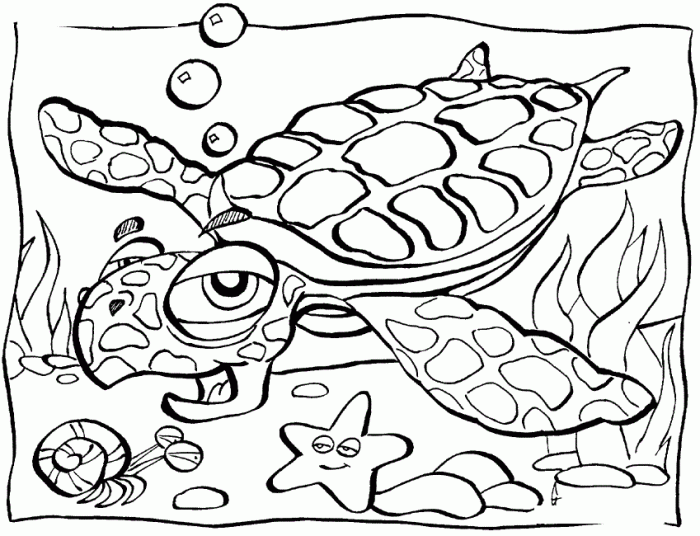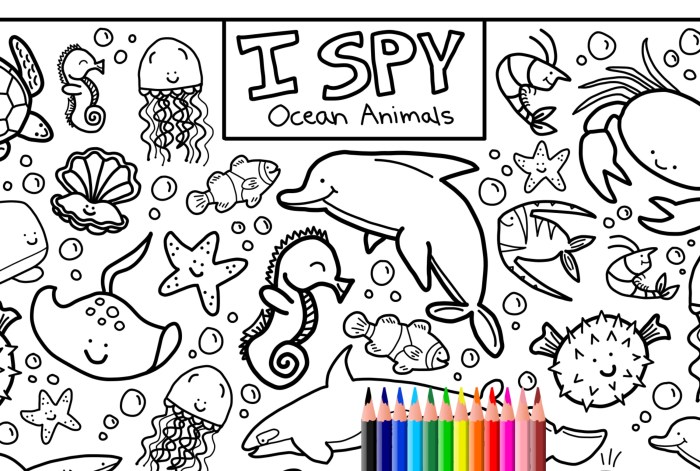Educational Value and Uses

Coloring pages of ocean animals – Ocean animal coloring pages offer a multifaceted approach to early childhood education, extending beyond simple entertainment. They provide a valuable tool for fostering cognitive development, artistic expression, and an appreciation for marine biodiversity and conservation. The engaging nature of coloring activities makes learning about the ocean and its inhabitants both fun and accessible for young children.Ocean animal coloring pages serve as effective educational aids by integrating learning with creative expression.
Children learn about various marine species through visual representation, associating names with images and developing a foundational understanding of their physical characteristics. Furthermore, the act of coloring itself enhances fine motor skills, hand-eye coordination, and focus, contributing to overall cognitive development.
Educational Benefits of Ocean Animal Coloring Pages
Coloring pages featuring ocean animals offer a range of educational benefits for children. They provide opportunities to learn about diverse species, their habitats, and the importance of marine conservation. The visual learning facilitated by these pages is particularly effective for young children, enhancing knowledge retention and comprehension. Moreover, the creative process of coloring encourages self-expression and builds confidence.
The activity also improves fine motor skills, hand-eye coordination, and concentration, contributing to broader cognitive development. For example, a coloring page depicting a sea turtle can introduce children to its physical characteristics, habitat (coral reefs or sandy beaches), and the threats it faces from pollution and habitat destruction. This visual learning can be complemented by accompanying text or verbal explanations, enhancing the learning experience.
Using Coloring Pages to Teach About Ocean Animals and Their Habitats
Coloring pages can be strategically employed to teach children about specific ocean animals and their habitats. A series of pages, each featuring a different animal like a dolphin, a seahorse, or a jellyfish, can introduce children to the diversity of marine life. Accompanying each page, brief descriptions of the animal’s characteristics, diet, and habitat can be provided, fostering deeper understanding.
For instance, a coloring page of a polar bear could include information about its Arctic habitat, its diet of seals, and the challenges it faces due to climate change. Similarly, a coloring page featuring a clownfish could introduce the concept of symbiosis with sea anemones and the importance of coral reefs. This method promotes visual association and contextual learning, creating a more engaging and memorable learning experience.
While coloring pages of ocean animals offer a vibrant underwater world, a shift to terrestrial creatures provides a different artistic experience. For a comprehensive collection of land-based animals, consider exploring the detailed illustrations available at the zoo animals coloring page website; returning to the ocean theme afterward allows for a fascinating contrast in both subject matter and artistic approach to coloring.
Promoting Creativity and Fine Motor Skills Through Coloring
The act of coloring itself offers significant developmental benefits. Choosing colors, staying within the lines, and applying varying pressure to create different shading effects all contribute to the development of fine motor skills. This activity also improves hand-eye coordination and strengthens hand muscles. Furthermore, coloring allows for creative expression; children can personalize their coloring pages, adding their own unique touches and interpretations.
This fosters self-expression, boosts confidence, and encourages imaginative play. For example, a child might choose vibrant colors to depict a colorful coral reef or use subtle shades to create a realistic representation of an ocean floor. This freedom of expression is a crucial aspect of the educational value of coloring pages.
Lesson Plan: Ocean Animal Coloring Pages and Marine Conservation, Coloring pages of ocean animals
The following lesson plan integrates ocean animal coloring pages to teach children about marine conservation:
- Introduction (10 minutes): Begin with a captivating video or slideshow showcasing the beauty and diversity of ocean life. Introduce the concept of marine conservation and its importance.
- Activity 1: Coloring Pages (20 minutes): Distribute coloring pages featuring various ocean animals facing threats, such as sea turtles entangled in plastic or coral reefs damaged by pollution. Encourage children to color the pages creatively.
- Discussion (15 minutes): Discuss the threats faced by the animals depicted in the coloring pages. Encourage children to share their observations and thoughts about the importance of protecting marine life.
- Activity 2: Creative Solutions (15 minutes): Provide art supplies and prompt children to create artwork depicting ways to protect ocean animals and their habitats. This could include posters, drawings, or models.
- Wrap-up (10 minutes): Review the key concepts discussed and emphasize the importance of individual actions in protecting the ocean environment. Encourage children to share their artwork and discuss their creative solutions.
Commercial Aspects and Availability

Ocean animal coloring pages represent a significant market within the broader children’s entertainment and educational resource sectors. Their accessibility and affordability contribute to their widespread popularity, while diverse distribution channels cater to a broad range of consumers. Understanding the commercial landscape, including pricing, copyright, and distribution methods, is crucial for both creators and consumers of these resources.The diverse range of platforms hosting ocean animal coloring pages reflects the accessibility of this type of content.
These pages are readily available across numerous digital and physical channels, each with its own unique pricing model and user experience.
Distribution Platforms
Ocean animal coloring pages are available across a wide variety of platforms. Websites dedicated to printable coloring pages often offer free downloads, supported by advertising revenue or premium subscription models. Dedicated apps for mobile devices provide interactive coloring experiences, sometimes offering in-app purchases for additional content or features. Physical books featuring collections of ocean animal coloring pages are sold in bookstores and online retailers, typically at a higher price point than digital alternatives.
Pricing Strategies
Pricing strategies vary considerably depending on the platform and the nature of the product. Free websites typically generate revenue through advertising or affiliate marketing. Paid apps often utilize a freemium model, offering basic content for free while charging for premium features or additional coloring pages. Physical coloring books typically have a fixed price, influenced by factors such as page count, paper quality, and brand recognition.
The price point reflects the production costs and the perceived value to the consumer. For example, a simple digital download might be free or cost a few dollars, while a high-quality printed book could cost upwards of $10-$20.
Copyright and Licensing
Copyright and licensing issues are paramount in the distribution of ocean animal coloring pages. Creators retain copyright over their original artwork, protecting their intellectual property rights. Free downloads often come with usage restrictions, prohibiting commercial use or redistribution without permission. Commercial platforms typically obtain licenses from artists or use artwork under Creative Commons licenses, which specify permissible uses.
Violation of copyright can lead to legal action, highlighting the importance of respecting intellectual property rights. Clear licensing agreements are crucial for ensuring legal and ethical distribution.
Creating a Simple Webpage
Creating a simple webpage to showcase ocean animal coloring pages is achievable using basic HTML. The following example demonstrates a basic structure:“`html

A fun and easy coloring page featuring a playful dolphin. Perfect for children of all ages!

This intricate octopus coloring page offers a challenge for older children and adults. Includes many details to color!

A majestic whale ready for your creative touch. Large enough for detailed coloring.
“`This example uses placeholder image URLs; these should be replaced with actual image URLs when creating a functional webpage. The
tags provide descriptions for each coloring page, enhancing the user experience. Further enhancements could include interactive elements and improved design.
Answers to Common Questions: Coloring Pages Of Ocean Animals
Where can I find free ocean animal coloring pages?
Many websites offer free printable ocean animal coloring pages. A simple Google search should yield numerous results. Be sure to check licensing information before using any pages for commercial purposes.
Are there coloring pages suitable for toddlers?
Yes, many websites and books offer simpler coloring pages with bolder Artikels and fewer details, perfect for toddlers. Look for pages with larger images and fewer intricate elements.
How can I use ocean animal coloring pages to teach about conservation?
Discuss the importance of ocean conservation while coloring. Point out endangered species and explain the threats they face. Encourage children to think about ways they can help protect the ocean environment.
What kind of paper is best for coloring ocean animal pages?
Heavier weight paper, such as cardstock, is ideal to prevent bleed-through, especially with markers or watercolors. Thicker paper also makes the finished coloring page more durable.
